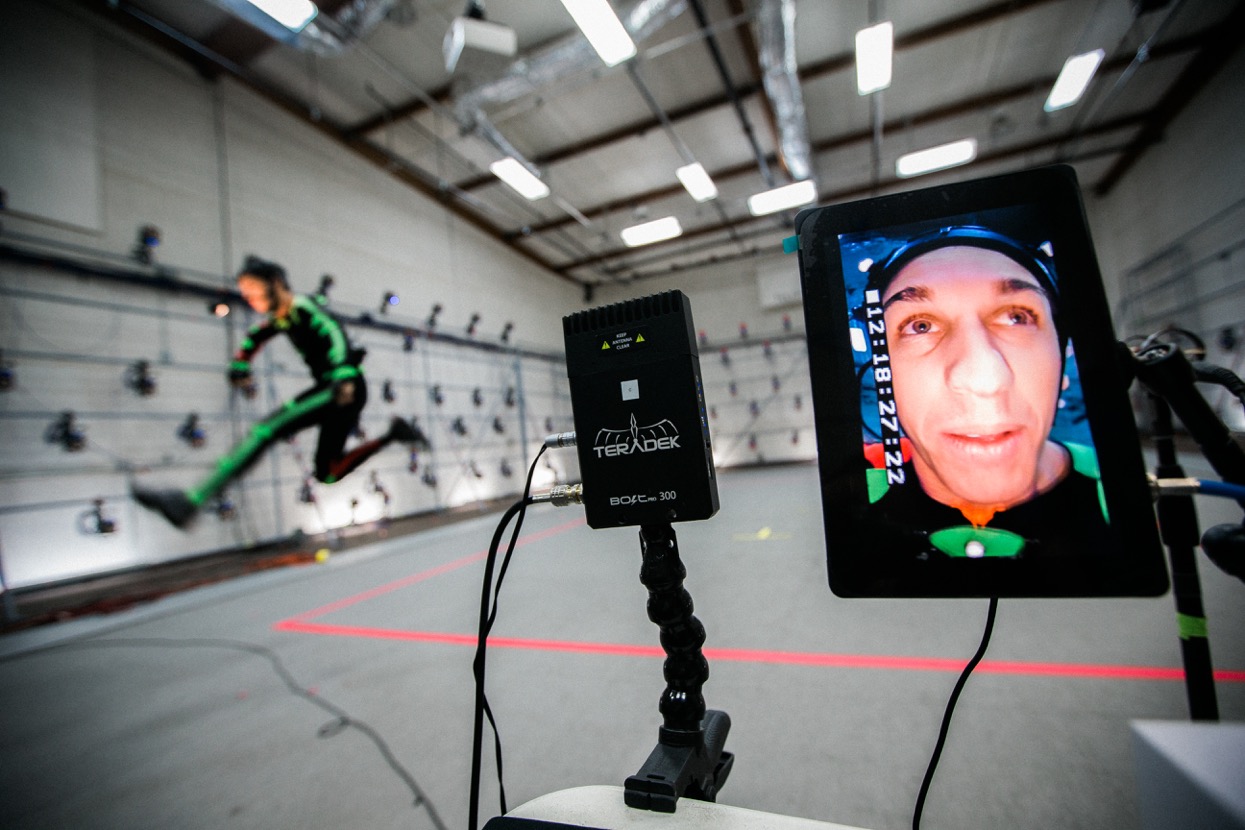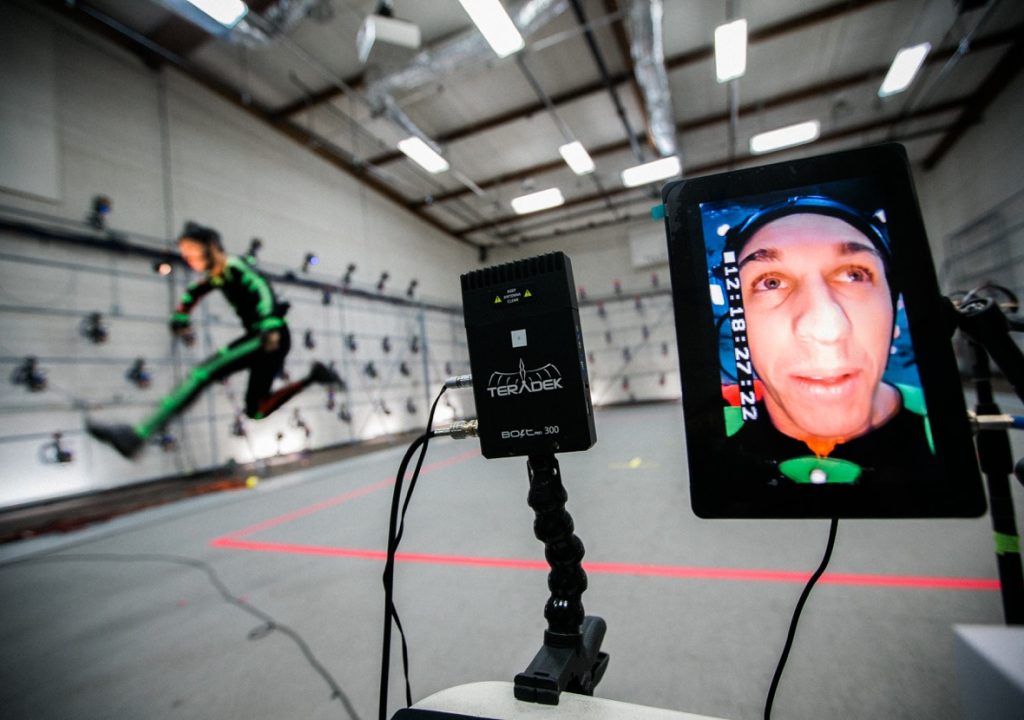
The Walk, written and directed by Robert Zemeckis, features Joseph Gordon-Levitt as high-wire artist Philippe Petit. The film is a biopic, but it highlights his high-wire walk between the Twin Towers of the World Trade Center in 1974. As you can imagine, there were some intense scenes that recreated this stunt, but the logistics of how the filmmakers were able to capture Gordon-Levitt’s performance without risking his life are almost as profound.
Those details are available in the release below, but the effects were made possible with a marker-less facial motion capture technology from Faceware, and their workflow was made simpler by using the Bolt Pro 300. I caught up with Topher DeLancy from Teradek to ask him a few questions about the kinds of issues that the Bolt can help clear up on productions of all sizes and plenty more.
ProVideo Coalition: How big of an issue is latency in professional productions?
Topher DeLancy: Latency can mean everything.
If you’re on a film set and the director is watching what’s happening live, but they look down at their monitor and there’s a one second delay, it’s going to throw off of all the consistency in the shoot. They’re going to think they saw something they didn’t see, or think they got a shot when they actually didn’t, or vice versa. It’s important from that regard to have zero-latency, but you also have to remember that you have a lot of different people on set who rely on real-time monitoring.
Say you’ve got a focus-puller, and they’re rolling with the camera, and everything is on a gimbal so it’s all hand-held and moving around. You need wireless video to go to the focus-puller’s monitor. You can’t run wires and cables through a scene. With that focus-puller having zero delay, they can see in real-time what’s happening and hit their marks when they need to pull focus. And latency will screw that up entirely.
When someone starts using the Bolt Pro 300, are they typically looking to solve a single issue, or a number of them?
It really depends on the client. Sometimes they’re looking for something simple, like someone just needs to allow their director to monitor with zero delay. And that’s obviously simple enough to resolve. But we also have broadcast clients who want the wireless video, but the switcher they’re using can only take 1080p60. The camera they’re using might only output at 1080p30, but the Bolt allows you to convert that to 1080p60. We’ve added an entire arsenal of additional features in our Bolts, like signal conversion and LUTs, to make it a versatile tool.
Faceware is a great example of a company that sees multiple benefits from using the Bolt, because they need the zero-latency as well as the uncompressed HD video. In fact, they’re actually capturing the uncompressed footage the Bolt is transmitting from the SDI source of the camera, then into an AJA KiPro at ProRes 422. So they’re getting a solid, uncompressed, clean crisp picture with zero delay, and it’s just as good as being cabled up.
What sort of feedback have you received from customers in terms of additional features or requested upgrades?
We’re always listening to our customers. The Bolt is only a couple years old, but if you compare what it is now to what it was, you can see a big difference. We’ve added a lot of features and we’re always looking to add more. Some examples of features that we added based on customer feedback include record flags, time-code, channel selection, in-field pairing and power safety just to name a few. These are extra things that you don’t get elsewhere, and are exclusive to our brand because we take the wireless technology and then we build around it.
One of the newer features that we added to the Bolt lineup is called integrated LUT. It allows you to load in the specific color profile you want into the Bolt so that when it’s outputting, it’s already looking the way you want it.
We don’t really sidestep anything. We’ve got the SDI connections, and we’ve got a rock-solid power connection. We built this product with the highest quality that we can, because you just can’t have anything go wrong on set. In fact, I just had a client come in with the very 1st Bolt Pro. She told us it was the first time it had stopped working. Ever. But actually, all it needed was a firmware update, because she had never updated it. So we updated it, and she was onset using it the next day.
We’ve got the essentials nailed down, which allows us to focus on some pretty great new features and functionality.
And some new products as well, correct?
Yes, absolutely. Customers have been telling us for a while now that they wanted a lightweight receiver which they can throw onto a portable monitor for their 1st AC or to the Director. They didn’t want to spend thousands of dollars for another receiver that they knew would get banged around and mistreated; they just wanted something stripped to the essentials with a specific amount of range.
So we listened to that and created the Bolt Sidekick. It works with all of our current Bolt models, so it will pair up with the Bolt 300, 600 or 2,000. And in a matter of months, we’ve developed and it’s now shipping.
It’s a product that you can use and take advantage of even if you’re not a current Bolt owner. Since most sets nowadays will already have a Bolt system on set, 1st AC’s, sound, script supervisors or even hair and make-up can bring a Sidekick to set and tap into A camera’s Bolt transmitter. That way, these departments have their own monitor rather than congesting video village.
It’s an inexpensive tool that can increase efficieny and solve problems before they happen during production, which can be absolutely essential in that environment.
Bolt In Motion with Faceware from Teradek on Vimeo.
Faceware “Walks” Wireless with Teradek
In the VFX-heavy blockbuster The Walk, written and directed by Robert Zemeckis, actor Joseph Gordon-Levitt had to undergo more than just wire walk training to pull off his performance in the film. It took fifty face replacements shots for Gordon-Levitt to accurately portray the emotional, psychological challenge that high-wire artist Philippe Petit experienced during his daring stunt.
Faceware is a marker-less facial motion capture company that builds, rents, and sells headcam systems and software that takes video of an actor’s face and adds those realistic movements to a finished CGI composition. With the help of this technology, Gordon-Levitt’s facial expressions were seamlessly implanted on the stunt performer in The Walk.
The Walk’s Visual Effects Supervisor Kevin Ballie elaborated on Faceware’s contribution, “We were able to take [Joe’s] actual facial performance and put it on the digital face that then went on Jade, the stunt performer’s body. So when you see a face replacement, it’s not just sticking Joe’s face on there, it’s sticking his performance on there as well. It’s Joe’s acting on Joe’s face on the stunt performer.”
Not only does Faceware specialize in facial motion capture, but they also record full body movement and sound, as well. When they started out back in 2006, Faceware had to deal with their actors being tethered to cumbersome cables. Performance Capture Supervisor Chris Jones commented on the inconvenience of that workflow, “We had these big set pieces with actors running around hitting their marks while we would follow them around with the cables, trying not to get them tangled or trip over them. Especially since we’re recording sound, you can’t have cables dragging around everywhere, so every shot was a whole choreography.”
To simplify their workflow, Facewire went wireless with Teradek’s Bolt Pro 300, a wireless transmitter with SDI connectivity. With the Bolt in place, they were able to transmit uncompressed 1080p60, 4:2:2 video up to 300ft over the 5GHz band.
“With our setup, we want to keep as much weight off the actor as possible. That’s why I love the Bolt system. It’s so light and the construction is solid with those HD-SDI connectors, the Lemo power, and the aluminum housing,” stated Jones. “We’ve smacked those things around a lot harder than they should be and they still work great. It also gives us the range we need for a sound stage, not to mention there’s almost zero latency so what you’re seeing is real time.”
Faceware could also control the real-time standards conversion of resolution and frame rate via the Bolt’s OLED screen. Best of all, the wireless video transmission from the Bolt is captured in Pro Res 422 through AJA boxes, which sends the feed to the VFX team for composting and final production. Ultimately, problems with latency, quality, and cables became fixable issues with Faceware incorporating the Bolt into their workflow, giving the company more time to focus on their work rather than worrying about their gear.
“Since we started using the Bolt system, life has gotten so much easier. These Teradek products are perfect for us.”

